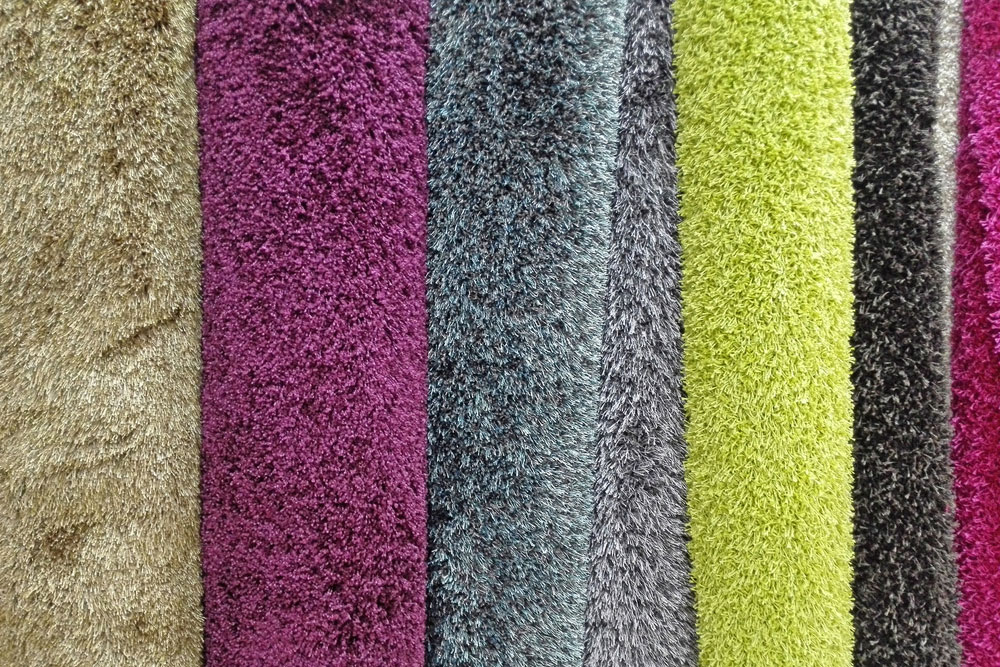Would you like to know more about your carpet? Perhaps you are looking to change the type of carpet you are using in a room. In any case, you should take a look at our list of the most common types of rug materials and rug fabrics.
1. Wool
Though wool is often wavey and unkempt in its traditional appearance, some woven wool rugs can take on a more elegant styling. But however the looks between rugs may vary, the material stays absorbent. So it will pick up moisture and hold it more than other fabrics.
This absorbency can result in longer drying times after a rug cleaning. But it is the price you pay for the softness of the material. On the upside of using a wool rug, they are often hardier and resistant to dust staining and general water damage. Fine Persian rugs often use wool.
2. Silk
Silk is certainly not as durable as the other materials on this list, but it does provide the opportunity for more ornate and intricate dying and pattern making. But this ability to absorb colors of all kinds makes it susceptible to discoloration and staining.
If you have an oriental rug, it may use pure silk rather than wool. You can test this for yourself by rubbing the surface of the rug vigorously with the palm of your hand. Silk will hold that heat, whereas synthetic fabrics will stay cool.
3. Seagrass
The feel and even look of seagrass is a dead giveaway. It has a very hard and coarse texture rather than the traditional softness of most rugs. It is made of yarn spun from dried plants and often left un-dyed, giving it a brownish and more earthy appearance.
These rugs are very resilient, and can hold up to excessive moisture and repel most stains. But it is not the most comfortable rug material, nor is it very versatile in its color options. Just as a silk rug is easier to stain and dye, the stain resistance of seagrass also makes it dye resistant.
4. Jute
Another plant-based carpet fiber, jute, comes from the jute plant. It is recognizable to anyone who has ever used a burlap bag at the grocery store, as burlap is also constructed out of jute. This material can stain and discolor very easily.
A jute rug can also require a lot of cleaning and will absorb water easily. The absorbancy and need for cleaning does create a hassle for many rug owners as it requires more time where the rug is unused so it can dry.
5. Polypropylene
As the name would suggest, polypropylene is a synthetic fiber. When it is unwoven, this material is often used in the medical field to create masks, gowns, caps, shoe covers, and many other single-use disposable items. So as you can guess, it is a rather inexpensive material.
But do not let its disposable medical uses fool you. Polypropylene is extremely durable and stain resistant in its woven form. Polypropylene rugs are soft and can even stand up to cleaning ages like bleach without losing the vibrancy of darker colors.
6. Polyester
Based on how popular polyester is as a fabric, chances are this is what your rug is made out of. As a petroleum byproduct, it is produced as a result of manufacturing gasoline, so there is enough of it around. As a synthetic, it can wick off moisture very easily, so it dries quickly.
Polyester also has a greater stain resistance than many fabrics, which also makes it a top choice for furniture covers. Just as it limits the need for upholstery cleaning, you can also avoid heavy staining that needs professional cleaning if you have a polyester rug.
7. Acrylic
Acrylic is often seen as extremely similar to polyester, as they are nearly always side by side on the shelf as synthetic fabric options. However, acrylic offers a lot more warmth. This is great for creating a cozy environment, but this is due to the fabric not breathing.
The breathability of fabric usually matters a lot in clothing, but in the case of rugs, it can create a much-welcomed pulse. You will experience a bit more water retention after cleaning for acrylic than polyester, and it is not as durable, but these differences do not have huge margins.
8. Cotton
This plant-based material is spun into a very soft and durable thread. The fabric is also very light, so you may be able to tell by the feel and weight of your rug that it is different from the synthetics you would pull off the shelf of a big box retail store.
Not all cotton rugs are reversible, but if your rug is reversible, there is a very good chance it is cotton. You may be tempted to flip the rug instead of calling a carpet cleaning company, but this is not recommended, as cotton’s ability to accept dyes of all colors does make it sustainable to permanent staining.
9. Fur
Rugs made out of fur, rather than wool, are an issue for many people who are concerned with animal conservation. This is because fur, as opposed to wool, stays a fixed length, so it does not need to be shorn for the animal’s health. Though fur can be very soft, it is very delicate.
There are few fur rugs made today as a result of conservation efforts, but if you have one, it is your responsibility to the animal to not have it degrade and fall apart. Keep your fur rugs in healthy condition with proper cleaning and stain removal.
